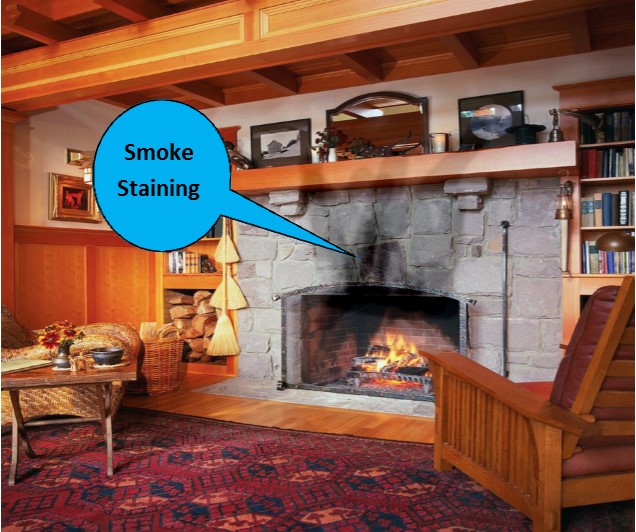Similarities between Chimneys and Straws Brochure
Is that open space between liners that big a deal?
Ok, why do I need to know about open spaces in my chimney? All I want to know is the chimney is safe to use. Well, that’s a valid question to ask, but it does require a little understanding of what your chimney does. Remember, smoke, heated gases, and some sparks use the chimney for a passageway from your fireplace or appliance to the great outdoors. Having gaps in between the liners could put yourself or your home in harm's way by letting these things escape!
Think again.
Think again.
|
Let’s look at this closely. If you have a chimney liner with 7”x7” interior dimensions and a 1/16th inch gap between the next liner, the open area equals 3 sq. inches. Place 9 more liners on top of this; with the same 1/16th of an inch opening collectively, you have 30.38 sq. inches. This is larger than a 6” hole. So that “not so bad mortar joint” may not be serving you or your chimney very well.
In another example, let’s ramp it up a little by taking a 13” x13” liner, which is common for a fireplace chimney. Consider a one-inch gap between the liners, which is not uncommon. We have 52 Sq. inch open area in one liner joint area. That’s larger than an 8” hole. Add 4 more liners to the top of this one, and you have a whopping 260” sq. inch opening, larger than an 18” round hole. |
Get the idea?
Chimneys operate under a negative pressure or vacuum, so how can we expect the chimney or fireplace to operate with gaps? If this was your vacuum cleaner, you would notice if it wasn’t working well.
Consider this example chimney in newer home construction or renovation of an older home. This could become a real problem in performance and energy efficiency. Tighter homes compete for air, so who will lose the battle for make-up air? Your Chimney! Even though there may be a brick or block to surround the liners, it will still leak air into the chimney. This can contribute to the summertime damp/smoky odor you may experience from time to time.
Also, remember when smoke and hot gases cool, they condense on the walls of the liners and roll down to the gap, and can enter into the interior chimney cavity. (not good!)
Something to keep in mind
Chimneys operate under a negative pressure or vacuum, so how can we expect the chimney or fireplace to operate with gaps? If this was your vacuum cleaner, you would notice if it wasn’t working well.
Consider this example chimney in newer home construction or renovation of an older home. This could become a real problem in performance and energy efficiency. Tighter homes compete for air, so who will lose the battle for make-up air? Your Chimney! Even though there may be a brick or block to surround the liners, it will still leak air into the chimney. This can contribute to the summertime damp/smoky odor you may experience from time to time.
Also, remember when smoke and hot gases cool, they condense on the walls of the liners and roll down to the gap, and can enter into the interior chimney cavity. (not good!)
Something to keep in mind
|
There are national recommendations from the building codes concerning this issue. Even though the codes explain in detail how clay liners are to be joined (NFPA 211 or IRC), both code bodies understand that the smallest hole can create a loss in performance when trying to exhaust smoke and gases from a fireplace or appliance. Gaps can create uncertainty on how the fireplace or appliance will operate under all conditions. Smoke and gases can move into other areas within the chimney cavity, creating more uncertainty.
|
Uncertainty is not your friend.
Remember you have a variety of solutions to stop the leaking, whether a chimney reline, resurface, or joint repair. If you were wondering if gaps are a big deal, yes, they are!!
What the sweep is telling you!
*Your chimney falls below recommended building codes.
* Even though the chimney may appear to operate, it does so in a limited ability. And the condition will only prematurely deteriorate the chimney at an accelerated rate.
*If you’re asking, “is it safe to use,” I cannot offer you any peace of mind in its current condition.
Today's technology and higher demands for efficiency and performance are now ramped up higher than before. So, yesterday's thought process will not work with today's reality.
Remember you have a variety of solutions to stop the leaking, whether a chimney reline, resurface, or joint repair. If you were wondering if gaps are a big deal, yes, they are!!
What the sweep is telling you!
*Your chimney falls below recommended building codes.
* Even though the chimney may appear to operate, it does so in a limited ability. And the condition will only prematurely deteriorate the chimney at an accelerated rate.
*If you’re asking, “is it safe to use,” I cannot offer you any peace of mind in its current condition.
Today's technology and higher demands for efficiency and performance are now ramped up higher than before. So, yesterday's thought process will not work with today's reality.
|
Here’s a demonstration to easily explain this problem.
|
Now, do you understand why there’s smoke staining on the front of your fireplace?




